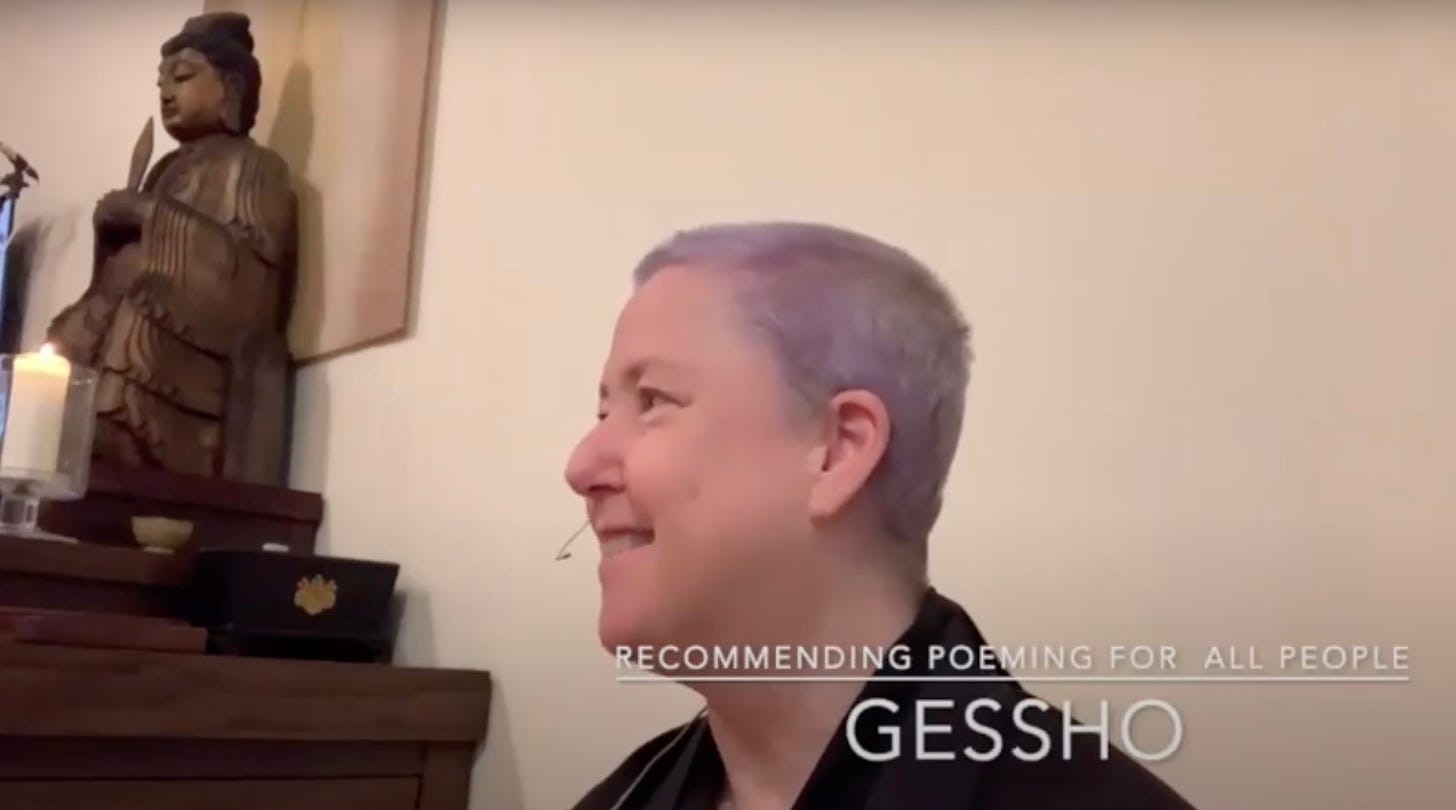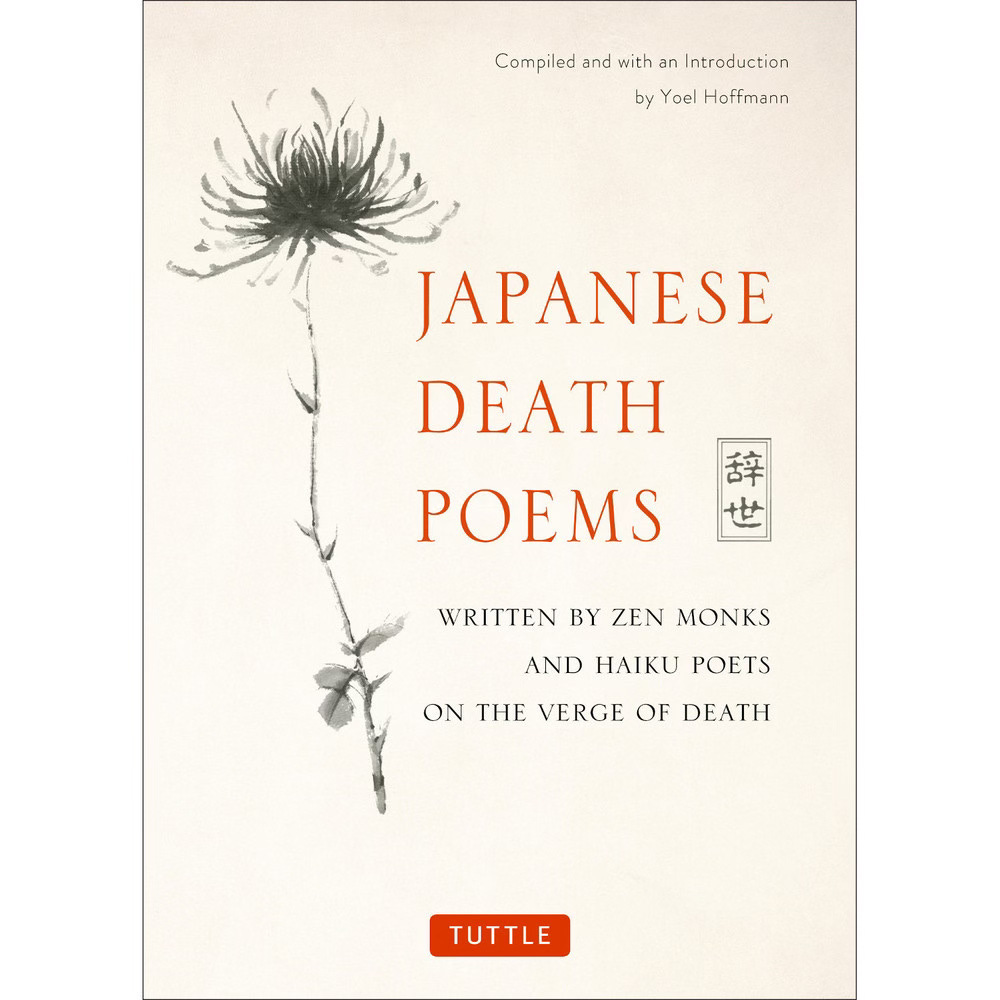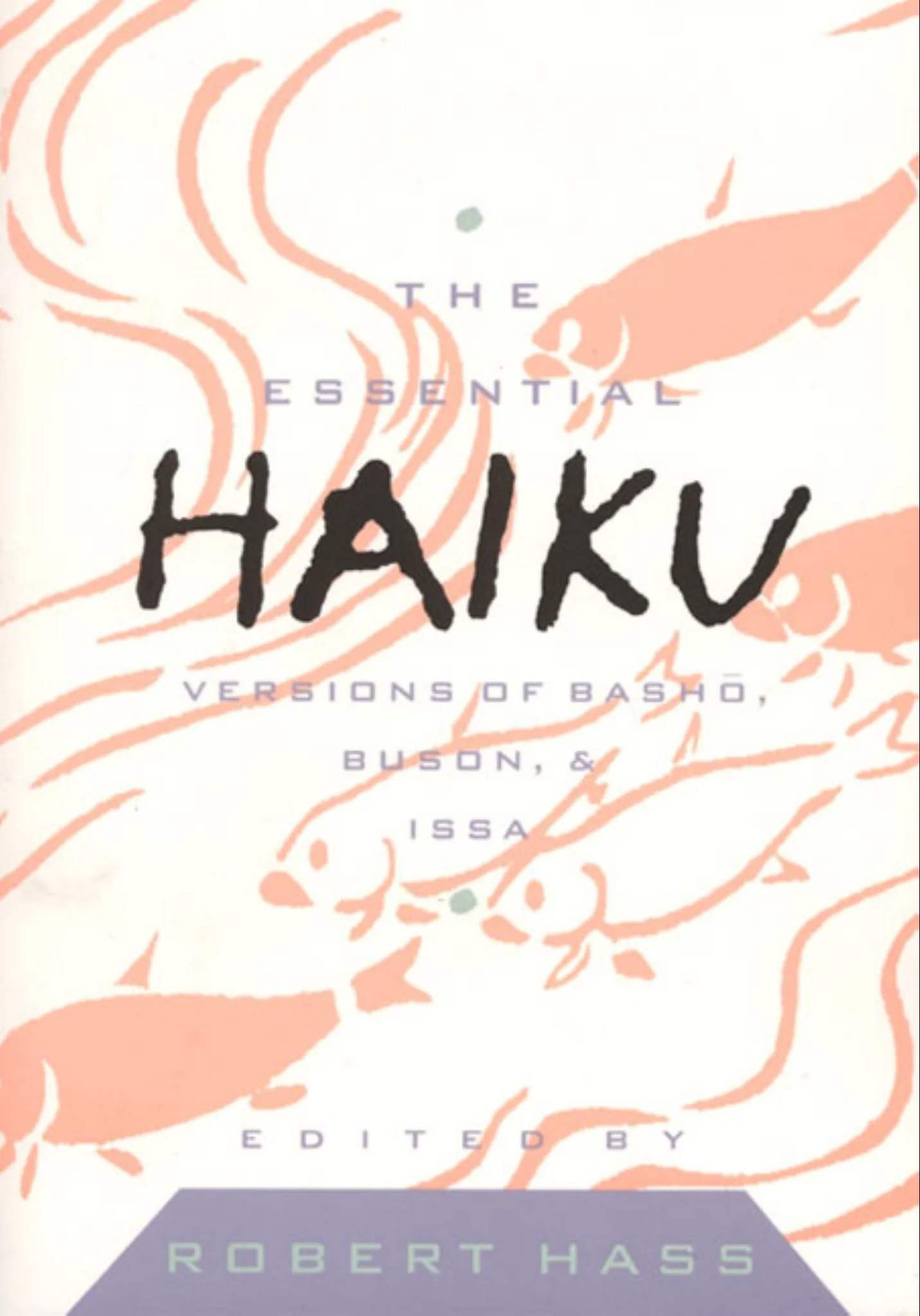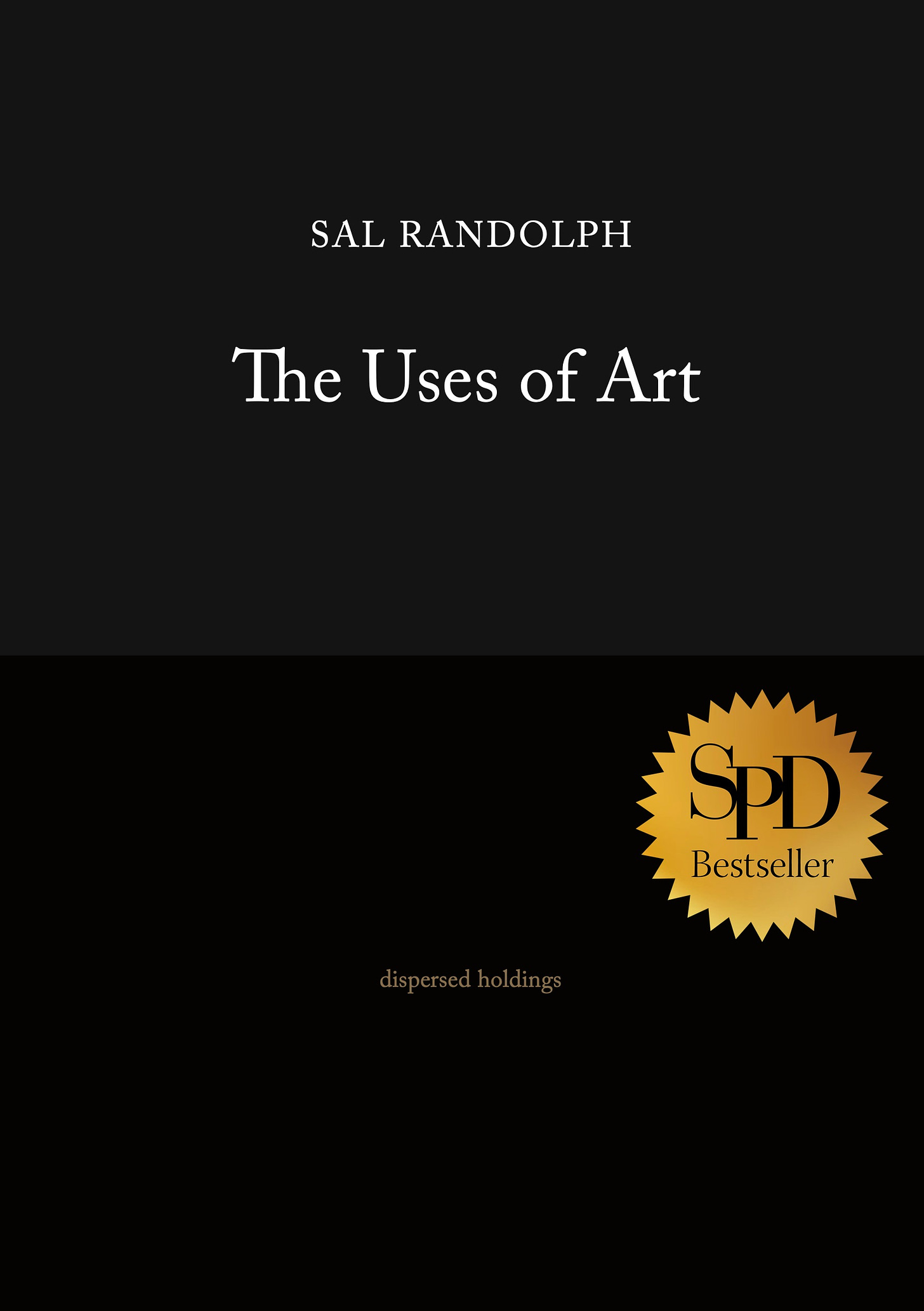Dear Friends,
Here’s a talk I gave in May as part of a series on Zen poetry. In this talk I share the last expressions of haiku poets, particularly Bashō and Buson.
I also suggest that we all take up poeming as a regular practice.
Do you poem? Or do you not? Either way, I’d love to hear from you in the comments.
— Sal (aka Gessho)
Video: Recommending Poeming to All People
Podcast
As an alternative, you can listen to the podcast version of this talk here.
Transcript: Recommending Poeming for All People
(This transcript has been lightly edited)
The dharma, incomparably profound and infinitely subtle
is rarely encountered, even in millions of ages.
Now we see it, hear it, receive and maintain it.
May we completely realize the tathagata’s true meaning.
— Gatha on Opening the SutraThe Path of Expression
As we were just chanting the Gatha on Opening the Sutra, about the Dharma being profound — infinitely profound and subtle — that we were going to see it and hear it, I was like, uh-oh.
Where are we gonna find that Dharma? I guess we're going to find it — whatever we find — we're going to find right here.
Today, I'm gonna talk about death, in particular about the tradition in Japan of writing poems in anticipation of your death.
I've been teaching a class recently. As many of you know, the Village Zendo runs a monthly class periodically. This year it’s called the Path of Expression, and we’ve been focusing on Zen Poetry.
There are four sessions for this class. We began in India, we traveled along with Zen to China, then we traveled to Japan, and eventually we'll end up in the United States. But in the most recent session, we were in Japan, and we we worked with haiku and with death poems, which are known as jisei in Japanese.
We worked with a particular kind of death poem, yuige — the final poems of Zen monks. Someone asked me after the class, do haiku poets also write death poems, not just monks? And I said, “why yes, they do!”
So I thought we would spend a bit of time exploring what I didn’t have time for during the class: the tradition of final haiku poems.
Final Haiku
This is Bashō, who's in some sense the inventor of the haiku as we know it. His last poem:
Sick on a journey, my dream hovers over the withered fields.
The “withered fields” are what's known as a kigo, or seasonal word. Most haiku have in a traditional — or even to some extent, formulaic — word that points to the precise season. It also points to the mood of the poem and all of the other poems that it might connect to which take place in that season.
Here it's withered fields, which is the season of late autumn or winter, as you can imagine. It was October when Bashō was dying. Robert Haas, who made this translation — he’s an American poet — speculated that Bashō wasn't just saying the withered fields, the actual fields out there. Instead Bashō was also saying that his mind was turning over the phrase withered fields, and seeing how he might make a poem of it. So it's a poem of the poet and a poem also of the moment.
About 90 years later, another great haiku poet, Yosa Buson, said said this to his caretaker when he was on his deathbed:
“Even being sick like this, my fondness for the way is beyond reason.”
The “way” he means there is the way of poetry, the way of haiku, but also our way, the Zen way. The way.
“Even being sick like this, my fondness for the way is beyond reason, and I try to make haiku. The high stage of my dream hovers over the withered fields is impossible for me to reach. Therefore, the old poet Bashō's greatness is supremely moving to me now.”
Buson nevertheless managed to write a poem after he said that. And in fact, he wrote three, so he has a sequence of three haiku from his dying. The first is:
Winter Warbler long ago in Wang Wei's hedge also.
Wang Wei was a great Tang dynasty poet of China, so Buson is looking back into history as well as the cycle of repetition that makes up our life.
Then he followed it up with:
Warbler, What sounds do you make in the frost-covered bush?
And in his final poem, he says:
In the white plum blossoms, night to next day just turning.
Just turning. Just that moment.
Japanese Death Poems
I’m going to read to you from a book called Japanese Death Poems. If you're curious about this writing practice and this way of relating to death, I definitely recommend this book. I’ll read read a few poems so you can get a sense of the flavor of this poetry — of this relationship to our lives and our deaths.
I'll say the name of the poet and then I'll just read the poem.
Asei:
Flowers of the grass: scarcely shown, and withered name and all.
Chogo:
I long for people — then again, I loathe them: end of autumn.
So, humor is also permitted!
Choha:
A raging sea, thrown from the deck — a block of ice.
You can just see that ice melting in to the water of the sea.
Gitoku:
Clear sky— the way I came by once I now go back by.
This is Hokusai, the great painter and creator of ukiyo-e prints:
Now as a spirit I shall roam the summer fields.
This is Issa, who was also one of the most important of the haiku poets. He had two. The first is:
What matter if I live on? a tortoise lives a hundred times as long.
And the second one is in this translation,
From one basin to another — stuff and nonsense.
but Robert Haas translated it in a way that's maybe a little clearer for us as Americans.
A bath when you're born a bath when you die how stupid.
Accepting death does not always mean being fully reconciled with all of its aspects.
I'll close with Ryokan, who is also one of the truly great Zen poets.
Now it reveals its hidden side and now the other — thus it falls an autumn leaf.
You can see that leaf turning over as it's falling from the tree.
Recommending Poeming for All People
As I've been teaching this class we have been writing poems as well as hearing them, studying them and thinking about them. I've come to feel that the practice of writing poems is a very central part of the Zen tradition.
There are plenty of Zen poets in America today, but we don't, as a culture, have the habit of continuously writing poetry as if it was a practice.
We have a tendency to put poetry up on the kind of a pedestal and to feel that to practice poetry, or to practice really any of the arts in this country, you must be good at it. And you must do it in a way that's in a way public and that contributes to our culture in some way.
I've started to see the practice of poetry very differently as something that we can do often and almost routinely, in the manner that we may think of our practice of zazen (meditation) as something that's just part of what we do.
So in zazen, we're practicing, well, Dogen calls it practice realization. For Dogen, the biggest puzzle in his heart when he was young was: if we're already enlightened, if we already have a Buddha nature, why do we need to practice? That was his driving question, his spiritual question throughout his life.
Where he came to is that there's no separation between practice and realization. There is no such thing as realization outside of practice, and there is no such thing as practice that does not include realization.
I think we could think of poems as the expressive aspect of our practice.
It's not the only possibility for expression — of course, there are a million others, but poems are a very accessible and simple way for us to touch down on our experience of a particular moment, to record and express what we notice inside ourselves as we move through the world.
Dogen has an essayt called, “Recommending Zazen for All People” (“Fukan-Zazengi”). I guess I'm now recommending poeming for all people, without taking it too seriously in that other way, without turning it into something else.
All My Poems are Death Poems
I want to come back to Bashō. On his deathbed, his students gathered around and were waiting for his last poem…
This is perhaps the downside of the tradition. There you are, busy dying, and people are hanging around trying to get a poem out of you for your legacy. And there's a lot of pressure, because the poems of all the other years are going to be in a sea of poems. Who cares about each one? But your last poem is going to end up in a little book of death poems. So, there's a lot of pressure there.
At first, Bashō just said, all of my poems are death poems. And I think this is true — of all poems, but of haiku especially — that they live in this moment. And another thing Dogen said is, “we're born and die 10,000 times a second.”
We are constantly being born, and we are constantly dying. And so we can treat this poeming practice as an expression of that now, now, now.
Bashō wrote a little treatise on how to write poetry. It's a short essay I found it in a book called The Essential Haiku which was compiled by Robert Haas. This is Bashō on poetry:
Learn about the pines from the pines, and about bamboo from the bamboo.
As we're hearing Bashō talk, hold this as an instruction for poetry , but also perhaps as an instruction for your practice of Zen.
Don’t follow in the footsteps of the old poets, seek what they sought.
Don't look only to the old Zen masters and the vast literature of everything that we keep from them. Seek directly from yourself.
The basis of art is change in the universe. What’s still has changeless form. Moving things change, and because we cannot put a stop to time, it continues unarrested. To stop a thing would be to halve a sight or sound in our heart. Cherry blossoms whirl, leaves fall, and the wind flits them both along the ground. We cannot arrest with our eyes or ears what lies in such things. Were we to gain mastery over them, we would find that the life of each thing had vanished without a trace.
So if we're trying to hold on, you'll find nothing in your hand.
Make the universe your companion, always bearing in mind the true nature of things — mountains and rivers, trees and grasses, and humanity — and enjoy the falling blossoms and the scattering leaves.
…
Once the mind achieves a state of concentration and the space between oneself and the object had disappeared, the essential nature of the object can be perceived. Then express it immediately. If one ponders it, it will vanish from the mind.
I think that says a lot about how we might also can approach our practice.
Karumi, or Lightness
Near the end of his life, Bashō developed a new aesthetic idea for haiku.
Haiku has some aesthetic principles that you might already be familiar with. There's the element of mono no aware, which is the awareness of the impermanence of things, the sense that everything you perceive is also passing away, an unsentimental poignancy.
There's yugen, which is depth or darkness. I heard Roshi Enkyo once describe it as the darkness at the bottom of the ocean — an aspect of the haiku, which is a bit mysterious, which is evoked but not fully explained.
And there's wabi. You're probably familiar with wabi and sabi. Wabi is poverty of design, the beauty of old things and of imperfect things. And sabi is a feeling of kind of austerity and loneliness, solitariness. All of these aesthetic qualities could be talks in themselves.
Late in his life, Bashō also developed this idea of karumi, or lightness, and he began to teach it to his students. He traveled to teach it, and he lost some students over it, who thought it was moving towards something too trivial.
Bashō described it as the impression of looking at a sandy bed of a shallow river: water you can see right through, something clear. He wanted people to not try so hard to evoke emotion, and also not to be clever.
Haiku originated in a kind of poetry game that was played among a group of people. And part of that game was allusions and various ways of cleverly connecting the poems — all of that lingered in haiku to some extent.
So part of what Bashō was saying is: let's leave all that behind. Let's just be right here.
One way that people evoked karumi was by removing all the verbs.
There are a few of Bashō's late haiku that have some of this feeling, all written in the last couple of years of his life:
this autumn,
why do I grow old?
a bird entering clouds white chrysanthemum:
not one speck of dust
meets the eye clear moon,
a boy afraid of foxes
walked home by his lover deep autumn—
my neighbor,
what is he doing? We're all like that, right?
And then his final poem, in Jane Hirshfield and Mariko Aratani’s translation:
on a journey, ill,
dreams scouring on
through exhausted fields That's the same poem we heard earlier:
Sick on a journey My dream hovers Over withered fields
In an essay on Bashō the poet Jane Hirshfield writes:
Having written it, he immediately composed another poem describing the wanderings of his dreaming mind, and called in Shikō, one of his students, asking which he preferred. Shikō failed to catch the first line and, too embarrassed to ask, simply said he thought the earlier one unsurpassable. Bashō answered, “I know I shouldn’t be writing haiku now, so close to my death. But poetry is all I’ve thought of for over fifty years. When I sleep, I dream about hurrying down a road under morning clouds or evening mist. When I awaken I’m captivated by the mountain stream’s interesting sounds or the calls of wild birds. Buddha called such attachment wrong, and of this I am guilty. But I cannot forget the haiku that have filled my life.
Is it attachment, or is it just awareness?
Ordinarily, I would close with a poem, but we've had many poems. Instead, I want to read you Bashō's description of the tree for which he was named — the Bashō tree — basically a kind of banana tree, with big arching leaves. He took his pen-name from this tree.
This is part of the essay on poetry I mentioned earlier. As you hear him speak about the tree, you can think about the way he's also speaking about poetry. We could also think about it as a way of speaking about our practice and our lives.
The leaves of the basho tree are large enough to cover a lute. When they flutter in the wind, they remind me of the injured tail of a phoenix, and when they are torn, they remind me of dragon’s ears. The tree does bear flowers, but unlike other flowers there is nothing gay about them. The big trunk of the tree is untouched by the ax, for it is utterly useless to build with. The monk Huai-su wrote on the leaves, and Chang Heng-ch’u saw the new leaves unfurling and took incentive in hsi studies. I love the tree, however, for its very uselessness. I take my ease in its shad and am fond of it because it so easily torn by wind and rain.
Do you poem? Would you poem? I’d love to hear from you.
More Information
Japanese Death Poems: Written by Zen Monks and Haiku Poets on the Verge of Death, compiled and introduced by Yoel Hoffmann, is available from Tuttle.
The Essential Haiku: Versions of Bashō, Buson, and Issa, edited by Robert Hass, is available from Ecco/Harper Collins.
Jane Hirshfield’s writing on Bashō is available as a PDF titled “Seeing Through Words: Matsuo Bashō,” from the Haiku Foundation, and also as a Kindle Single under the title The Heart of Haiku.
More on Buson’s death poems here.
More on haiku and kigo, or season words in this post.
You can read a brief interview with me in the Village Zendo Bulletin about poeming and the Path of Expression (along with some reflections from students) here.
If you enjoyed this post, you’ll also enjoy my book, The Uses of Art.
Artist Sal Randolph’s THE USES OF ART is a memoir of transformative encounters with works of art, inviting readers into new methods of looking that are both liberating and emboldening.
Dazzlingly original, ferociously intelligent.
— Michael Cunningham
A joyful, dazzling treasure-box of a book.
— Bonnie Friedman
Here’s a guide, to waking up, over and over again.
— Roshi Pat Enkyo O’Hara









I poem. Love this Sal!
I loved reading these! Thank you. I feel that Zen and the haiku are waiting for me and for a time when I can pare things back but what really resonated was the idea of writing from first-hand experience rather than emulating other writers. I taught literature at a university for 30 years and have a doctorate in modernist literature but when I came to write my own poems (out of a freewriting practice) I was determined to separate myself from any attempt to 'match up to' T.S. Eliot or even my beloved H.D. (Hilda Doolittle). I was also determined to write poems that would be accessible to everybody and I think I achieved this because the spoken word perfomances that followed were generally liked. People would come up to me and say 'I don't like poetry but I liked that!' So, to cut a long story short (sorry!) I am indeed someone who does poeming, very close to your definition. And what a lovely new word you've invented!